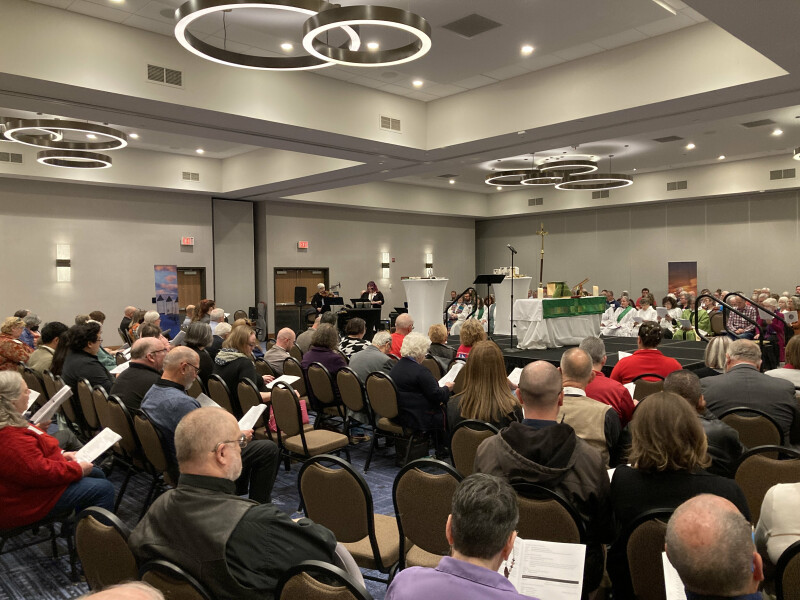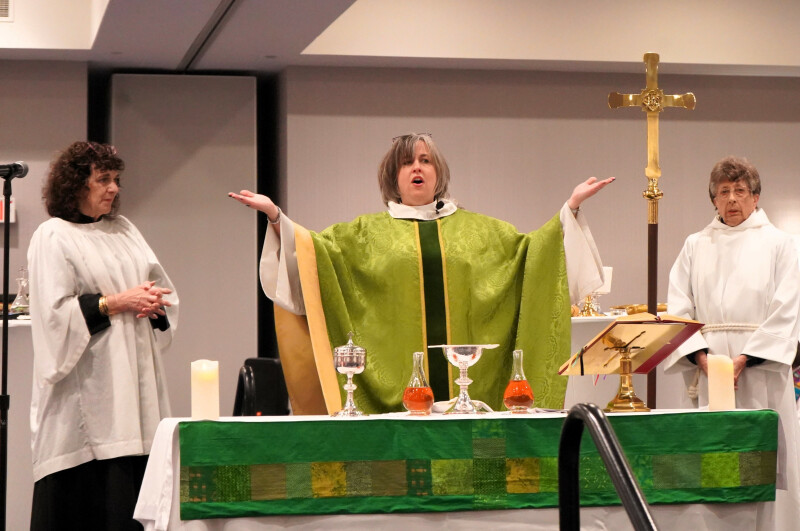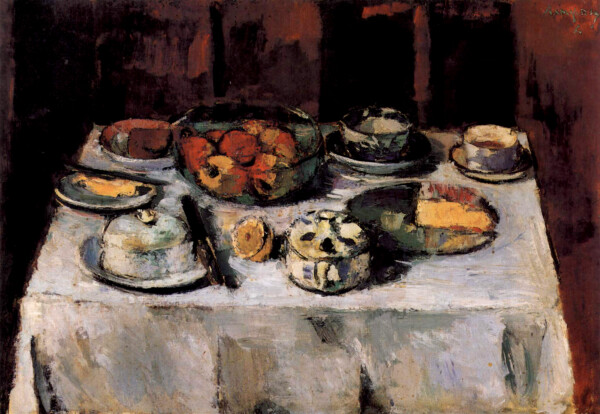

Dear Theologian,
In the front of every one of our churches, there is an altar. As an old-timer, I remember when it used to be against the east wall of the church. The priest would stand facing the altar, with his back to us. But now, I hear people calling it a “table,” and the priest stands behind it, facing us. Why the change? And what is the difference between calling it an altar and calling it a table?
Person in the Pews
Dear Pew-Person,
The form of Eucharist with which many of us grew up was the inheritance of the medieval period of Western Christianity. It must be recognized frankly that this form of the Eucharist was far removed in outward appearance and in spirit from the “primitive Eucharist” of the first believers.
In the very earliest days of the faith, the symbolism of a shared meal was uppermost in the outward form of the Eucharist. This style of celebration was believed to derive from the Lord himself, who had instituted it at his Last Supper with his closest disciples.
At that meal (which may have been a Passover meal), Jesus had taken a familiar Jewish table ritual and given it a new depth of meaning with reference to himself and his imminent death for the sake of his friends. Sharing in this symbolic meal, then, was the ever-repeated occasion when the early believers entered into the meaning of his life and death, experienced his risen presence in their midst, and committed themselves to live by his way.
In the medieval period, when very few of the laity even received Communion, the meal symbolism was preserved only in an atrophied form insofar as the priest-celebrant consumed the consecrated bread and wine. But what was uppermost in the medieval form of the Eucharist was the theme of “sacrifice.”
The priest was believed to offer up to God, in an “unbloody” way, the very same infinitely precious sacrifice that once was offered up in a bloody way on Calvary. Or, putting the matter more carefully, the same Christ who offered himself once and for all to the Father (for the salvation of all mankind) was believed now to be making his eternal sacrifice present, in the symbolism of the Mass and through the ministry of the ordained priest, for the benefit of those assembled.
In this understanding of the ritual of the Mass, the table where the bread and wine were placed was thought of as an altar, on which the sacrifice was offered.
Until the liturgical renewal of the twentieth century, all Catholic churches (Anglican as well as Roman) had an altar against the back wall of the sanctuary, often very ornate and imposing. In a sense, the altar symbolized the Mystery of God, toward which the whole congregation was oriented, and which the priest approached reverently in the name of the people.
The fact that the priest had his back turned to the people showed that he was there not primarily to dialogue with them or even to address them, but rather to lead them into the holy presence of God and to offer on their behalf the Sacrifice of the Mass. The people’s part was to look on with faith and devotion and to join themselves in spirit with what was being done on their behalf by the ordained priest.
The renewed theology and practice of the Eucharist in both the Anglican and the Roman churches has returned to the biblical meal symbolism of early Christianity. In so doing, the significance of the altar/table has changed considerably.
Churches built since the renewal ordinarily reflect the new understanding and practice in their physical arrangement of space. Older church buildings are adapted as well as possible to the new form of Eucharist, either by moving the original altar out into the middle of the sanctuary or (if this is not possible) by setting up a table as close to the body of the congregation as possible (leaving the original altar in place as a kind of backdrop).
The essential symbolism of the Eucharist, in its renewed form, is that of a shared Meal in which all participate. The focal point of the assembled congregation is now a table, on which are placed ordinary, basic food and drink (bread and wine) in plain view of all, with the obvious purpose of being provided for everyone eventually to eat and drink together.
Before sharing this symbolic Meal, a great prayer of praise and thanks is intoned at the table by the person who is “presiding,” in order to express the deep religious meaning of the Meal, and in order to give voice to the faith and love of all those who are gathered around the table. At its conclusion, the entire assembly sings or says “Amen!” to express their agreement and conviction.
Notice the different function of the priest-celebrant in this form of the Eucharist. He/she is there to focus the faith of the assembled people, to give voice to it, and to draw all of them together around the one table, in readiness to “take and eat.” The priest-celebrant is not doing something on their behalf, namely, offering a sacrifice that they are not empowered to offer. Rather, he/she is leading a great communal action, which all those present are doing together.
One final point: Granted that the outward form of the Eucharist is now much more clearly that of a symbolic Meal, what has happened to the theme of “Sacrifice”?
The theme of Sacrifice is still expressed in some of the prayers, even though the outward action itself no longer thematizes this meaning so explicitly. In fact, the deepest meaning of Jesus himself and of his death is “redemptive sacrifice”—a handing-over and abandonment of himself to the Father, in which all men and women are somehow included, so that they are reconciled in principle to the God from whom they have been willfully estranged.
This loving abandonment to the will of the Father, this gift of self to God, is really the “essence” of the crucified and risen Jesus upon whom the community feeds, with whom the community is joined in the sacred Meal.
“Sacrifice,” therefore, is a major theme in the meaning of participating in the Meal. By sharing in the Lord’s Supper, we all freely share in his Sacrifice and are caught up into his own eternal act of loving surrender to the Father on behalf of the world. But the outward, symbolic form of our identification with Jesus’ Sacrifice is the form that he himself chose to give us: the simple, ordinary behavior of breaking bread together at his Table.
Faithfully,
The Theologian
The Rev. Wayne L. Fehr writes a monthly column for the diocesan newsletter called "Ask a Theologian," answering questions from ordinary Christians trying to make sense of their faith. You can find and purchase his book "Tracing the Contours of Faith: Christian Theology for Questioners" here.





